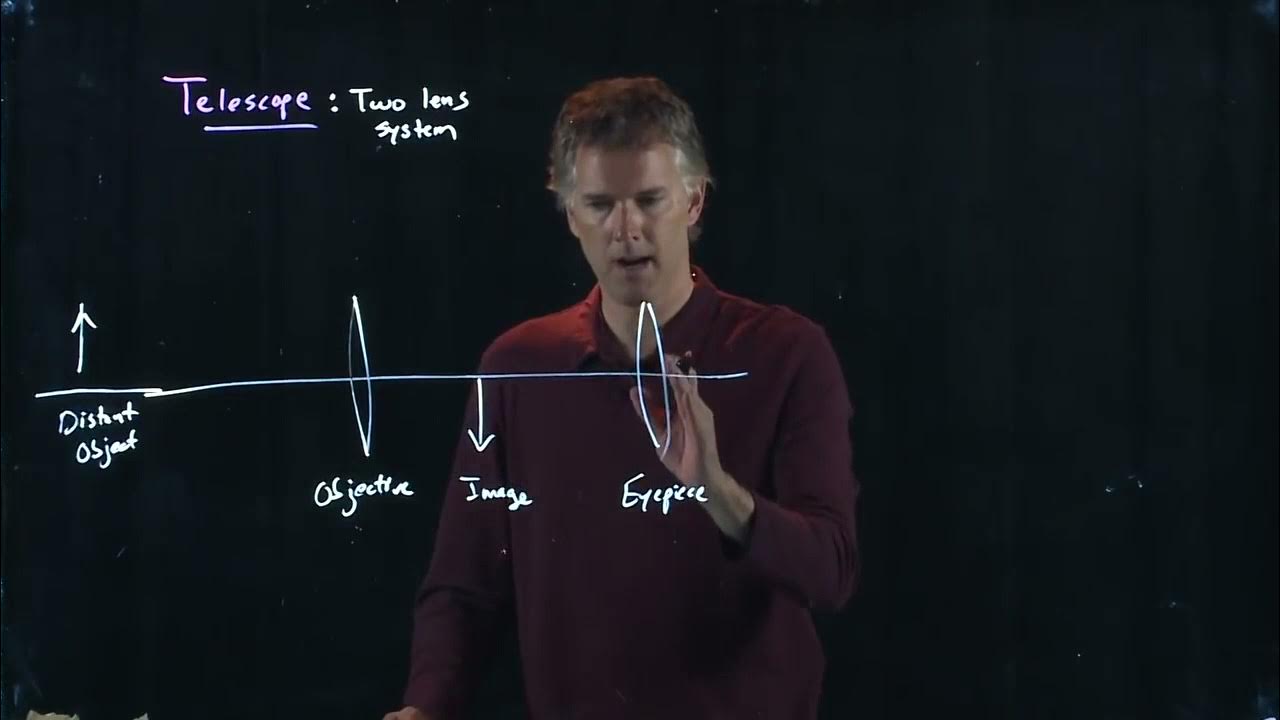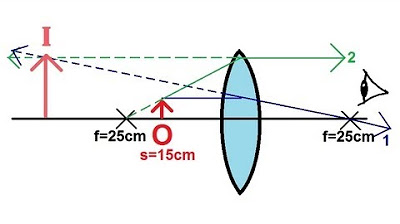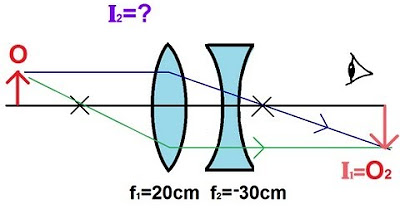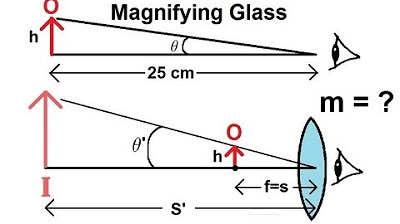How telescopes work | Class12 (India) | Physics | Khan Academy
TLDRThis script offers an insightful exploration into the functioning of telescopes using the moon as an example. It explains the principle of magnification with a magnifying glass and its limitations due to focal length. The video demonstrates how a telescope, with its objective lens, brings distant objects closer, creating an inverted real image. Subsequently, an eyepiece, akin to a magnifying glass, magnifies this image, making celestial bodies appear much larger. The script concludes with a practical demonstration highlighting the basic working principle of telescopes, despite the challenges of using non-ideal lenses and manual positioning.
Takeaways
- 🔭 Telescopes magnify distant objects by bringing them closer to the viewer, similar to how a magnifying glass works but at a much larger scale.
- 🌕 The moon is used as an example of a distant object that a telescope can magnify, but it cannot be magnified with a simple magnifying glass due to its great distance.
- 🔎 A magnifying glass requires the object to be within its focal length to magnify properly; otherwise, the image appears blurred.
- 📏 The focal length of the magnifying glass used in the script is approximately 20-25 centimeters, much too short to magnify the moon, which is thousands of kilometers away.
- 🌌 The principle of a telescope involves using a convex lens (objective lens) to bring a distant object closer and then magnifying the resulting image with a second lens (eyepiece).
- 📡 The objective lens of a telescope creates an inverted image of the distant object at its focal point, which is much closer than the actual object.
- 👀 The eyepiece, or magnifying glass in this context, is used to magnify the image created by the objective lens, provided it is placed at the right distance from the image.
- 📚 Understanding the concept of focal length and how light rays interact with lenses is crucial to comprehend how telescopes work.
- 🛠 The quality of the lenses used in a telescope affects the clarity of the magnified image; imperfect lenses can cause distortions.
- 📸 The demonstration in the script shows that even with non-ideal lenses, a telescope can provide a magnified view of the moon, albeit with some blurring.
- 🔬 The script emphasizes the importance of aligning the telescope's lenses correctly to achieve the desired magnification and image clarity.
Q & A
What is the primary purpose of a magnifying glass?
-The primary purpose of a magnifying glass is to magnify objects that are within its focal length, making them appear larger and more detailed to the viewer.
Why does a magnifying glass fail to magnify the moon when held close to the eyes?
-A magnifying glass fails to magnify the moon because the moon is outside the focal length of the lens. The moon is thousands of kilometers away, which is much farther than the focal length of a typical magnifying glass.
What is the role of the objective lens in a telescope?
-The objective lens in a telescope is responsible for gathering light from a distant object, such as the moon, and bringing that object into focus at a closer distance, effectively magnifying the image of the object.
What is the term used for the lens that is kept close to the eye in a telescope?
-The lens that is kept close to the eye in a telescope is called the eyepiece. It is used to magnify the image formed by the objective lens.
How does the eyepiece (magnifying glass) work in conjunction with the objective lens?
-The eyepiece works by receiving the magnified image formed by the objective lens and further magnifying it when the image is placed within its focal length, allowing the viewer to see a larger and more detailed image of the distant object.
What is the significance of the principal focus in the context of the telescope?
-The principal focus is the point where the light rays from a distant object converge after passing through the objective lens. It is significant because it is the location where the inverted and magnified real image of the object is formed, which is then magnified further by the eyepiece.
Why are the rays of light from the moon considered to be parallel when drawing a ray diagram for a telescope?
-The rays of light from the moon are considered parallel when drawing a ray diagram because the moon is at such a great distance that the light rays appear to come from nearly the same direction, simulating a point at infinity.
What causes the image of the moon to appear blurred when viewed through an ideal telescope?
-The image of the moon would not appear blurred in an ideal telescope. However, in the script, the image appears blurred due to the use of non-ideal lenses with distortions and the manual handling of the lenses and camera, which can introduce instability and misalignment.
What is the difference between the focal length of the objective lens and the eyepiece in a telescope?
-The focal length of the objective lens is typically longer and is used to gather light and form an image of a distant object at its principal focus. The eyepiece, with a shorter focal length, is used to magnify this image when placed close to the observer's eye.
How does the script demonstrate the principle of a telescope?
-The script demonstrates the principle of a telescope by explaining how a convex lens (objective) brings a distant object closer and then uses another lens (eyepiece) to magnify the image of that object, allowing for a larger and more detailed view.
What additional factors might affect the clarity of the image when using a telescope as described in the script?
-Additional factors that might affect the clarity of the image when using a telescope include the quality of the lenses used, atmospheric conditions, and the stability of the telescope mount, in addition to the manual handling mentioned in the script.
Outlines
🌕 Understanding Telescopes with a Magnifying Glass
This paragraph introduces the concept of telescopes by comparing them to a magnifying glass, which is a convex lens. The narrator explains that a magnifying glass cannot be used to view distant objects like the moon because they are beyond its focal length, resulting in a blurred image. The focal length of the magnifying glass is compared to the vast distance of the moon, illustrating the need for a device that can 'bring the moon closer.' The principle of a telescope is then described as using a convex lens (the objective lens) to gather light from a distant object and create an image at a closer distance, which can then be magnified by a second lens (the eyepiece). The paragraph concludes with a theoretical explanation of how the objective lens works, using rays of light to demonstrate the formation of an inverted image at the principal focus.
🔍 Demonstrating Telescope Magnification
The second paragraph continues the explanation of how telescopes work, focusing on the practical demonstration of magnification. It describes how the magnifying glass, or eyepiece, is used in conjunction with the objective lens to magnify the image of the moon. The narrator emphasizes the importance of placing the magnifying glass at the right distance so that the image formed by the objective lens falls within the focal length of the eyepiece. This results in the light rays becoming parallel after refraction, which can then be focused by the eye onto the retina, creating a large image. The paragraph concludes with a demonstration showing the moon's image without and with the telescope, noting the limitations due to the quality of the lenses used and the manual handling of the equipment, which causes some blurriness in the final image.
Mindmap
Keywords
💡Telescope
💡Magnifying Glass
💡Convex Lens
💡Focal Length
💡Blurred Image
💡Principal Axis
💡Objective Lens
💡Eyepiece
💡Inverted Image
💡Refraction
💡Real Image
Highlights
Exploring the working principle of telescopes using the moon as an example.
Introduction of a magnifying glass as a convex lens to demonstrate the concept of magnification.
Explanation of why a magnifying glass cannot be used to see a clear image of the moon due to its distance exceeding the lens's focal length.
Clarification on the focal length's role in the magnifying process and reference to previous videos for more details.
Theoretical demonstration of how a convex lens can bring a distant object, like the moon, closer by focusing its light.
Illustration of light rays from the moon and their path through the convex lens to form an image.
Description of the objective lens's purpose in a telescope to bring distant objects closer for magnification.
The concept of the principal focus of the objective lens and its focal length in creating an image.
Use of a magnifying glass, or eyepiece, to magnify the image formed by the objective lens.
Requirement for the magnifying glass to be within its focal length of the image to magnify it properly.
Demonstration of the magnification process with a real image of the moon formed by the objective lens.
Explanation of how the eye perceives the magnified image and the resulting large appearance of the moon.
Discussion on the practical challenges of using real lenses, such as distortion and clarity issues.
A practical demonstration showing the magnified moon using a homemade telescope setup.
Comparison of the moon's appearance without and with the telescope to illustrate the magnification effect.
Acknowledgment of the limitations in the demonstration due to non-ideal lenses and manual handling.
Conclusion summarizing the principle of how a telescope works based on the demonstration.
Transcripts
Browse More Related Video

The Magnifying Glass | Physics with Professor Matt Anderson | M28-10

The Telescope | Physics with Professor Matt Anderson | M28-13

Physics - Optics: Lenses (4 of 4) Converging Lens

Physics 59 Optical Instruments (3 of 20) The Microscope

Physics - Optics: Lenses (3 of 5) Lens Combinations - Converging & Diverging Lenses

Physics 59 Optical Instruments (1 of 20) Magnifying Glass
5.0 / 5 (0 votes)
Thanks for rating: